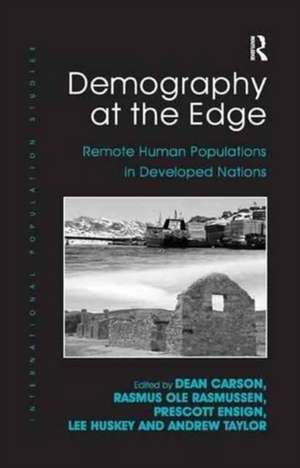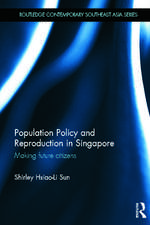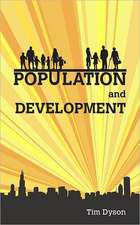Demography at the Edge: Remote Human Populations in Developed Nations
Autor Rasmus Ole Rasmussen Editat de Dean Carson Autor Prescott Ensign, Lee Huskeyen Limba Engleză Paperback – 17 noi 2016
| Toate formatele și edițiile | Preț | Express |
|---|---|---|
| Paperback (1) | 479.41 lei 6-8 săpt. | |
| Taylor & Francis – 17 noi 2016 | 479.41 lei 6-8 săpt. | |
| Hardback (1) | 1067.35 lei 6-8 săpt. | |
| Taylor & Francis – apr 2011 | 1067.35 lei 6-8 săpt. |
Preț: 479.41 lei
Nou
Puncte Express: 719
Preț estimativ în valută:
91.74€ • 95.24$ • 76.50£
91.74€ • 95.24$ • 76.50£
Carte tipărită la comandă
Livrare economică 25 martie-08 aprilie
Preluare comenzi: 021 569.72.76
Specificații
ISBN-13: 9781138267992
ISBN-10: 1138267996
Pagini: 372
Dimensiuni: 156 x 234 mm
Greutate: 0.69 kg
Ediția:1
Editura: Taylor & Francis
Colecția Routledge
Locul publicării:Oxford, United Kingdom
ISBN-10: 1138267996
Pagini: 372
Dimensiuni: 156 x 234 mm
Greutate: 0.69 kg
Ediția:1
Editura: Taylor & Francis
Colecția Routledge
Locul publicării:Oxford, United Kingdom
Notă biografică
Associate Professor Dean Carson is the Head of Population Studies at The Northern Institute, Charles Darwin University in Australia's Northern Territory; Associate Professor Rasmus Ole Rasmussen is attached to the Department of Geography and International Studies at the University of Roskilde in Denmark and works as a Senior Research Fellow with the Nordic Centre for Spatial Development (NORDREGIO) in Sweden; Dr Prescott Ensign is an assistant professor with the Telfer School of Management at the University of Ottawa in Canada; Lee Huskey is the Professor of Economics at the University of Alaska Anchorage and Andrew Taylor is a Population Researcher with The Northern Institute at Charles Darwin University, Australia
Recenzii
'Overall, the editors and other contributors to Demography at the Edge provide an accessible and informative introduction to the social demography of remote areas in developed countries. By reviewing a broad set of methodological and substantive topics, and complementing them with numerous case studies, they give readers a necessary baseline of knowledge about remote area demography. Their book contains important lessons for academics, policymakers, and local stakeholders...' Journal of Regional Science
Cuprins
I: Methods, Models and Data; 1: Perspectives on ‘Demography at the Edge'; 2: The Challenge of Enumeration and Population Estimation in Remote Areas; 3: The Forecasting of Remote Area Populations: Numbers Aren't Everything; 4: International Immigration Trends and Data; 5: Indigenous Vitals: Trends and Measurement; II: The Dynamics of Populations at the Edge; 6: Bubbles and Craters: Analysing Ageing Patterns of Remote Area Populations; 7: Transnational Links at the Edge; 8: Indigenous Demography: Convergence, Divergence, or Something Else?; 9: The ‘Problem' of Indigenous Migration in the Globalised State; 10: Labour Migration: ‘What goes around comes around'; 11: Fly-in/Fly-out Resource Developments: Implications for Community and Regional Development; 12: Why the Other Half Leave: Gender Aspects of Northern Sparsely Populated Areas; 13: Education, Remoteness and Population Dynamics; 14: Tourist Populations and Local Capital; 15: The Challenge of Housing in Remote Areas; 16: Weather Hazards, Place and Resilience in the Remote Norths; 17: Population Policies at the Edge: The Demographic Ambitions of Frontiers
Descriere
Addressing the methodological and topical challenges facing remote demographers, this book compares and contrasts the research, methods and models, and policy applications from remote regions in developed nations. The work draws upon four examples: the far north and desert regions of Australia, the northern provinces and territories of Canada, Alaska, and the Arctic north of Scandinavia.
















